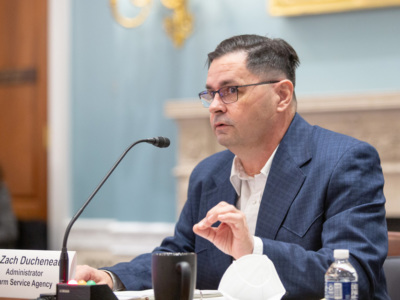Farm groups are calling for Agriculture Department loan program payment rates to be increased in the upcoming farm bill, while agency officials look at other ways to make the programs more accessible and flexible for producers.
Around 41% of 4,344 young farmers surveyed by the National Young Farmers Coalition in 2022 said finding access to capital was “very or extremely challenging.” Only around 7.3% of the survey’s participants were able to access operating microloans from the agency, while only 5.2% used farm operating loans.
USDA's direct operating loans are currently capped at $400,000, while direct ownership loans are limited to $600,000. Guaranteed operating and ownership loans are capped at $1.825 million. Microloans are capped at $50,000.
The issue was also before a House Ag Committee hearing last year when a panel of farmers cited challenges finding loans that kept up with high land prices and inflation. Some of the participants proposed increasing limits in USDA loan programs during a farm bill listening session last year.
 American Farm Bureau Chief Economist Roger CryanAmerican Farm Bureau Federation Chief Economist Roger Cryan told Agri-Pulse that as of the March Consumer Price Index, inflation was up by 25% from when the last farm bill was signed, which means the amount farmers need to borrow has increased as well.
American Farm Bureau Chief Economist Roger CryanAmerican Farm Bureau Federation Chief Economist Roger Cryan told Agri-Pulse that as of the March Consumer Price Index, inflation was up by 25% from when the last farm bill was signed, which means the amount farmers need to borrow has increased as well.
“A dollar doesn’t buy what it did five years ago when the last farm bill was passed,” Cryan said.
An increase in loan limits will be needed to help farmers get started or handle challenging events, Cryan said, adding that unlike other types of assistance, loan programs tend to pay themselves off since farmers must repay the balance with interest.
Rob Larew, president of the National Farmers Union, said accessing credit has been challenging for several NFU members. He said it’s important for these programs to help farmers dealing with tight margins and increasing costs, while also being “flexible” enough to support different types of production.
“We need to make sure that these programs are flexible enough that they can be designed to address beginning farmers today,” Larew said. “That’s not just one kind of farmer, but a diverse range of production.”
David Howard, the policy campaigns co-director for the National Young Farmers Coalition, believes an Inflation Reduction Act program may help unserved farmers access credit in the upcoming farm bill. The Increasing Land, Capital and Market Access Program utilizes $300 million in IRA funding for cooperative agreements and grants meant to help underserved producers.
The program aims to help farmers deal with challenges in accessing land, whether that be through obtaining capital or markets. Howard said this program should be added to the farm bill and receive annual funding once the IRA funds run out.
“With the demographics that we’re seeing in aging farm ownership, in land being converted — we need to move now,” Howard said. “This is the farm bill to really focus on land access and we think that this program could be a critical way to invest in that need.”
Don’t miss a beat! It’s easy to sign up for a FREE month of Agri-Pulse news! For the latest on what’s happening in Washington, D.C. and around the country in agriculture, just click here.
Producers, including those who addressed the House Ag Committee last year, have also said loan applications can be burdensome. In response, USDA has implemented an online application process for direct loans and reduced the application for direct loans from 29 pages to 13 pages.
Zach Ducheneaux, administrator of USDA's Farm Service Agency, told members of the National Association of Agricultural Journalists in Washington, D.C., this week that he is working make existing loan programs more accessible and flexible. He said there should be no reason why USDA doesn’t “defer a payment of principal” as long as it is “getting the interest as agreed to and the security remains.”
 FSA Administrator Zach Ducheneaux
FSA Administrator Zach DucheneauxDucheneaux also pointed to a community development financial institution (CDFI) for native producers he worked on before his appointment at FSA. The model used by the CDFI, he said, puts “the best deal on the table first.”
“There's an opportunity there to leverage that flexibility and to strike up a meaningful conversation with our friends in the lending industry about how we could support them in being more flexible for our producers,” Ducheneaux said. “Because in all my travels doing this for 25 years, I have yet to hear a producer say, 'I wish the lender would be a little more restrictive with me.'”
Speaking earlier this month on Agri-Pulse Newsmakers, Ducheneaux said he hoped changes in USDA's lending approach could also spur changes in how commercial banks deal with producers.
For more news, go to www.Agri-Pulse.com.


